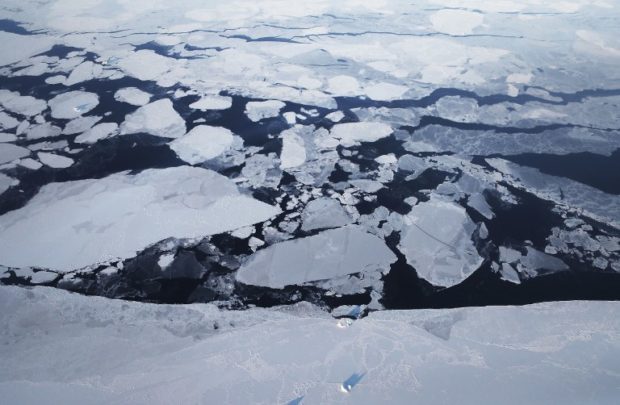Greenland now a major driver of rising seas — study

Sea ice is seen from NASA’s Operation IceBridge research aircraft off the northwest coast on March 30, 2017, above Greenland. AFP
PARIS, France — Ocean levels rose 50 percent faster in 2014 than in 1993, with meltwater from the Greenland ice sheet now supplying 25 percent of total sea level increase compared with just five percent 20 years earlier, researchers reported Monday.
The findings add to growing concern among scientists that the global watermark is climbing more rapidly than forecast only a few years ago, with potentially devastating consequences.
Hundreds of millions of people around the world live in low-lying deltas that are vulnerable, especially when rising seas are combined with land sinking due to depleted water tables, or a lack of ground-forming silt held back by dams.
Major coastal cities are also threatened, while some small island states are already laying plans for the day their drowning nations will no longer be livable.
“This result is important because the Intergovernmental Panel on Climate Change (IPCC)” — the UN science advisory body — “makes a very conservative projection of total sea level rise by the end of the century,” at 60 to 90 centimeters (24 to 35 inches), said Peter Wadhams, a professor of ocean physics at the University of Oxford who did not take part in the research.
Article continues after this advertisementThat estimate, he added, assumes that the rate at which ocean levels rise will remain constant.
Article continues after this advertisement“Yet there is convincing evidence — including accelerating losses of mass from Greenland and Antarctica — that the rate is actually increasing, and increasing exponentially.”
Greenland alone contains enough frozen water to lift oceans by about seven meters (23 feet), though experts disagree on the global warming threshold for irreversible melting, and how long that would take once set in motion.
“Most scientists now expect total rise to be well over a meter by the end of the century,” Wadhams said.
The new study, published in Nature Climate Change, reconciles for the first time two distinct measurements of sea level rise.
The first looked one-by-one at three contributions: ocean expansion due to warming, changes in the amount of water stored on land, and loss of land-based ice from glaciers and ice sheets in Greenland and Antarctica.
‘A major warning’
The second was from satellite altimetry, which gauges heights on the Earth’s surface from space.
The technique measures the time taken by a radar pulse to travel from a satellite antenna to the surface, and then back to a satellite receiver.
Up to now, altimetry data showed little change in sea levels over the last two decades, even if other measurements left little doubt that oceans were measurably deepening.
“We corrected for a small but significant bias in the first decade of the satellite record,” co-author Xuebin Zhang, a professor at Qingdao National Laboratory of Marine Science and Technology in China’s Shandong Province, told AFP.
Overall, the pace of global average sea level rise went up from about 2.2 millimeters a year in 1993, to 3.3 millimeters a year two decades later.
In the early 1990s, they found, thermal expansion accounted for fully half of the added millimeters. Two decades later, that figure was only 30 percent.
Andrew Shepherd, director of the Centre for Polar Observation and Modeling at the University of Leeds in England, urged caution in interpreting the results.
“Even with decades of measurements, it is hard to be sure whether there has been a steady acceleration in the rate of global sea level rise during the satellite era because the change is so small,” he said.
Disentangling single sources — such as the massive chunk of ice atop Greenland — is even harder.
But other researchers said the study should sound an alarm.
“This is a major warning about the dangers of a sea level rise that will continue for many centuries, even after global warming is stopped,” said Brian Hoskins, chair of the Grantham Institute at Imperial College London. CBB